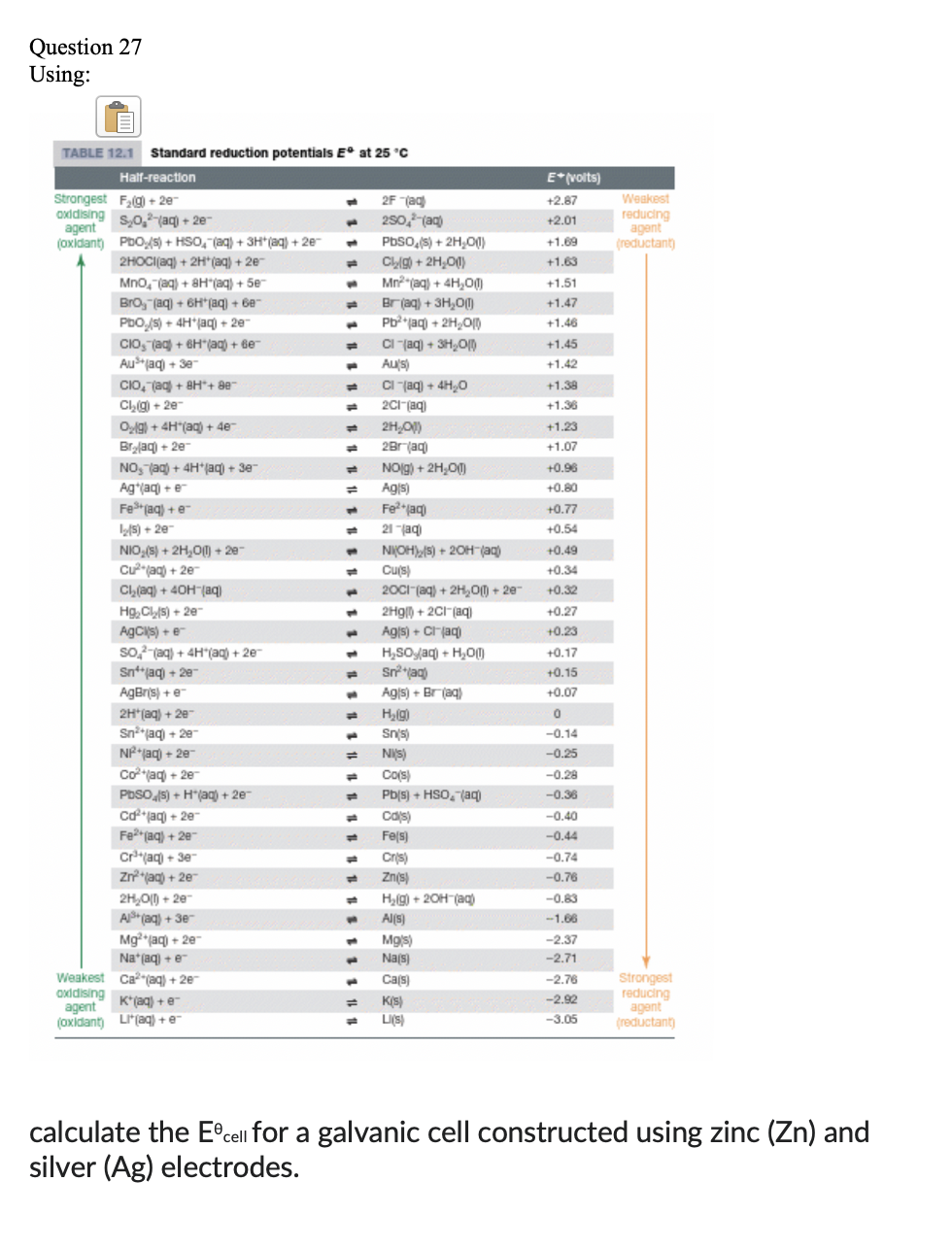Chemistry: An Atoms First Approach
2nd Edition
ISBN:9781305079243
Author:Steven S. Zumdahl, Susan A. Zumdahl
Publisher:Steven S. Zumdahl, Susan A. Zumdahl
Chapter17: Electrochemistry
Section: Chapter Questions
Problem 60E
Related questions
Question

Transcribed Image Text:Question 27
Using:
TABLE 12.1 Standard reduction potentials Eº at 25°C
Half-reaction
Strongest F₂(g) +20
oxidising
agent
(oxidant)
S₂0₂² (aq) + 2e-
PbO (s) + HSO, (aq) + 3H*(aq) + 2e
2HOCI(aq) + 2H+ (aq) + 2e
MnO₂ (aq) + 8H(aq) + 5e
Bro, (aq) + 6H(aq) + 6e-
PbO(s) + 4H(aq) + 2e
CIO, (aq) + 6H(aq) + 6e-
Aus+ (aq) + 3e
CIO, (aq) + 8H+ 8e™
Cl₂(g) +2e-
O₂(g) + 4H(aq) + 4e¯
Br₂(aq) +2e
NO₂ (aq) + 4H+ (aq) + 3e-
Ag*(aq) + e
Fe³+ (aq) + e
1₂5) +2e-
NIO₂ (s) + 2H₂O() +20
Cu²+(aq) + 2e-
Cl₂(aq) + 40H(aq)
Hg₂Cl(s) + 2e™
AgC(s) + e
SO2 (aq) + 4H(aq) + 2e
Sn+ (aq) + 29-
AgBr(s) + e-
2H¹(aq) + 2e™
Sn²+ (aq) + 29-
NP2²+ (aq) + 2e™
Co²+ (aq) + 2e
PbSO4(s) +H*(aq) + 2e™
Cd²+ (aq) + 2e-
Fe²+ (aq) + 2e-
Cr³+ (aq) + 3e-
Zn²+(aq) + 2e
2H₂O(l) +2e
Al³+ (aq) + 3e
Mg²+ (aq) + 2e™
Na+ (aq) + e
Weakest Ca²(aq) + 2e
oxidising
agent
(oxidant) L(aq) + e
K*(aq) + e
-
1
1
M
T
-
=
=
=
=
1
=
T
T
-
1
-
-
1
M
T
-
=
T
1
T
T
T
-
-
-
=
2F (aq)
250,- (aq)
PbSO,(s) + 2H₂O(1)
Ch₂(g) + 2H₂O(1)
Mn² (aq) + 4H₂O(1)
Br (aq) + 3H₂O(1)
Pb²+ (aq) + 2H₂O(1)
Cl(aq) + 3H₂O(l)
Aus)
Cl(aq) + 4H₂O
2Cl(aq)
2H₂O)
2Br (aq)
NO(g) + 2H₂O(1)
Agis)
Fe²+ (aq)
21-(aq)
NI(OH) (s) + 2OH(aq)
Cu(s)
2001 (aq) + 2H₂O(1) + 2e-
2Hg() + 2Cl(aq)
Ag(s) + Cl(aq)
H₂SO (aq) + H₂O(1)
Sn²+ (aq)
Agis) + Br (aq)
H₂(g)
Sn(s)
Nis)
Co(s)
Pb(s) + HSO₂ (aq)
Cals)
Fe(s)
Cris)
Zn(s)
H₂(g) + 2OH(aq)
Al(s)
Mg(s)
Na(s)
Ca(s)
K(s)
LI(S)
E* (volts)
+2.87
+2.01
+1.69
+1.63
+1.51
+1.47
+1.46
+1.45
+1.42
+1.38
+1.36
+1.23
+1.07
+0.96
+0.80
+0.77
+0.54
+0.49
+0.34
+0.32
+0.27
+0.23
+0.17
+0.15
+0.07
0
-0.14
-0.25
-0.28
-0.36
-0.40
-0.44
-0.74
-0.76
-0.83
-1.66
-2.37
-2.71
-2.76
-2.92
-3.05
Weakest
reducing
agent
(reductant)
Strongest
reducing
agent
(reductant)
calculate the Eºcell for a galvanic cell constructed using zinc (Zn) and
silver (Ag) electrodes.
Expert Solution
This question has been solved!
Explore an expertly crafted, step-by-step solution for a thorough understanding of key concepts.
Step by step
Solved in 2 steps with 2 images

Knowledge Booster
Learn more about
Need a deep-dive on the concept behind this application? Look no further. Learn more about this topic, chemistry and related others by exploring similar questions and additional content below.Recommended textbooks for you

Chemistry: An Atoms First Approach
Chemistry
ISBN:
9781305079243
Author:
Steven S. Zumdahl, Susan A. Zumdahl
Publisher:
Cengage Learning

Chemistry
Chemistry
ISBN:
9781305957404
Author:
Steven S. Zumdahl, Susan A. Zumdahl, Donald J. DeCoste
Publisher:
Cengage Learning


Chemistry: An Atoms First Approach
Chemistry
ISBN:
9781305079243
Author:
Steven S. Zumdahl, Susan A. Zumdahl
Publisher:
Cengage Learning

Chemistry
Chemistry
ISBN:
9781305957404
Author:
Steven S. Zumdahl, Susan A. Zumdahl, Donald J. DeCoste
Publisher:
Cengage Learning


Chemistry: The Molecular Science
Chemistry
ISBN:
9781285199047
Author:
John W. Moore, Conrad L. Stanitski
Publisher:
Cengage Learning

Chemistry: Principles and Reactions
Chemistry
ISBN:
9781305079373
Author:
William L. Masterton, Cecile N. Hurley
Publisher:
Cengage Learning

Chemistry & Chemical Reactivity
Chemistry
ISBN:
9781133949640
Author:
John C. Kotz, Paul M. Treichel, John Townsend, David Treichel
Publisher:
Cengage Learning